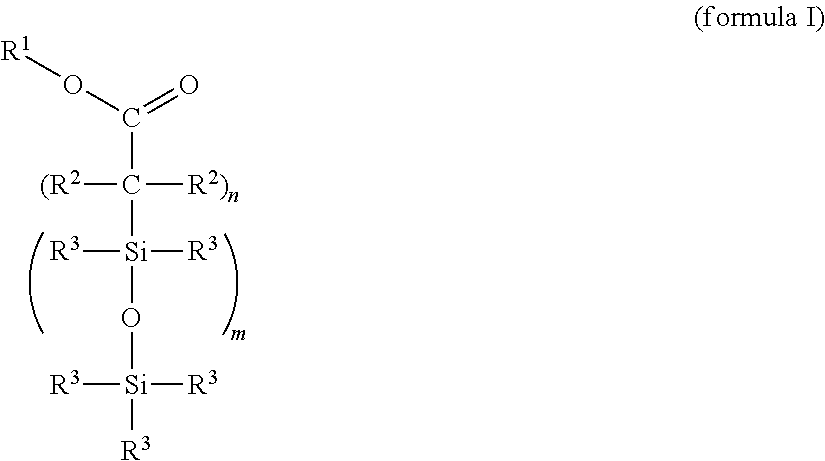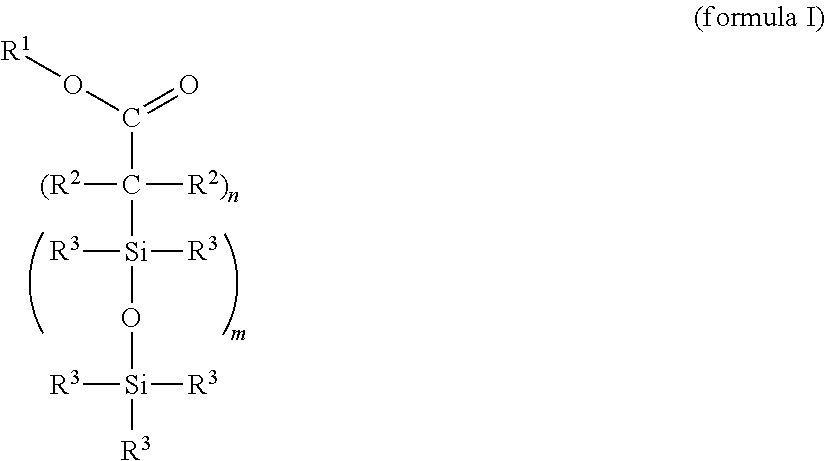Cross-linkable silicone composition
a silicone composition and cross-linking technology, applied in the direction of coatings, etc., can solve the problems of increasing antibacterial resistance bacterial strains, biofilm formation, and the entire system cannot be antibacterially effective, and achieve rapid cross-linking, good storage stability, and long pot life
- Summary
- Abstract
- Description
- Claims
- Application Information
AI Technical Summary
Benefits of technology
Problems solved by technology
Method used
Image
Examples
example 1
Synthesis of the compound (X):
[0119]One possible synthesis route for incorporating functional groups which permit a bonding to the PDMS network is the equilibration reaction of suitable precursors that is widespread in silicone chemistry. This type of bonding constitutes, by way of example, one option to produce the compound (X) and should not have a limiting effect on the scope of protection of the application since the synthesis route exhibits no influence on the effectiveness.
[0120]Stage 1:
[0121]Preparation of an α,ω-succinic anhydride-functional silicone by hydrosilylation of 2-allylsuccinic anhydride and an α,ω-Si—H-terminal polydimethylsiloxane with an average chain length of 50 D units: under precious metal catalysis (metals of the platinum group, preference being given to platinum compounds), the reaction of the H-terminal silicone polymer with 2-allylsuccinic anhydride takes place preferably at about 90-110° C. The synthesis takes place with equimolar feed based on the func...
example 2
Synthesis of the compound (X):
[0124]Stage 1: Preparation of an α,ω-functional silicone by hydrosilylation of acrylic acid trimethylsilyl ester (propenoic acid trimethylsilyl ester) and an α,ω-Si—H-terminal polydimethylsiloxane with an average chain length of 50 D units: under precious metal catalysis (Pt metals), the reaction of the H-terminal silicone polymer with acrylic acid trimethylsilyl ester takes place preferably at about 90-110° C. The synthesis takes place with equimolar feed based on the functional groups (Si—H and vinyl). An excess or deficit of the individual reactants is likewise possible.
[0125]Stage 2: Functionalization for the bonding to silicone elastomers analogously to example 1, where the ratio of carboxylic acid ester groups:vinyl groups=1:5.
example 3
Synthesis of the compound (X):
[0126]Proceeding from undecenoic acid triisopropylsilyl ester, the compound (X) is prepared analogously to example 1, where, in stage 2, the ratio of carboxylic acid ester groups:vinyl groups=1:2.
PUM
| Property | Measurement | Unit |
|---|---|---|
| adhesion | aaaaa | aaaaa |
| solubility | aaaaa | aaaaa |
| concentration | aaaaa | aaaaa |
Abstract
Description
Claims
Application Information
 Login to View More
Login to View More - R&D
- Intellectual Property
- Life Sciences
- Materials
- Tech Scout
- Unparalleled Data Quality
- Higher Quality Content
- 60% Fewer Hallucinations
Browse by: Latest US Patents, China's latest patents, Technical Efficacy Thesaurus, Application Domain, Technology Topic, Popular Technical Reports.
© 2025 PatSnap. All rights reserved.Legal|Privacy policy|Modern Slavery Act Transparency Statement|Sitemap|About US| Contact US: help@patsnap.com


